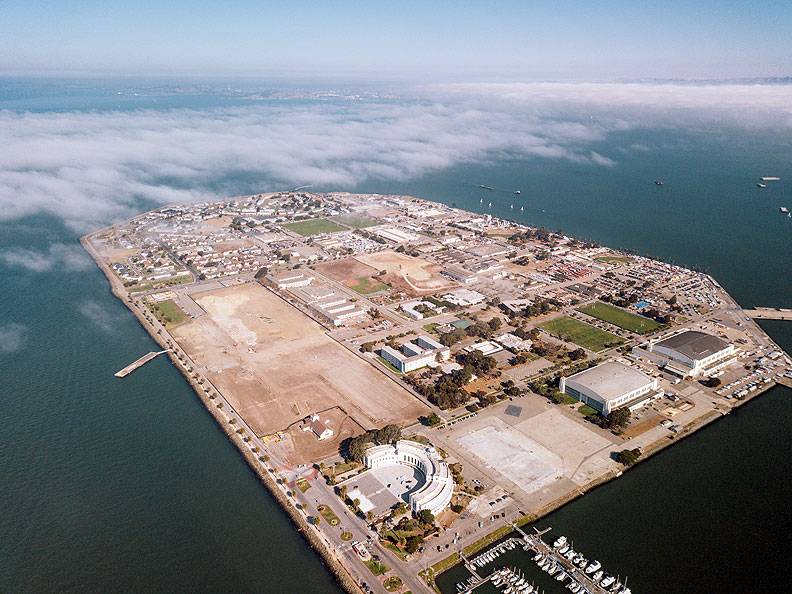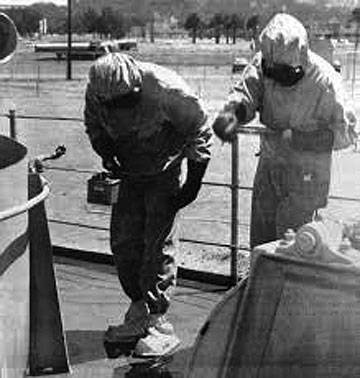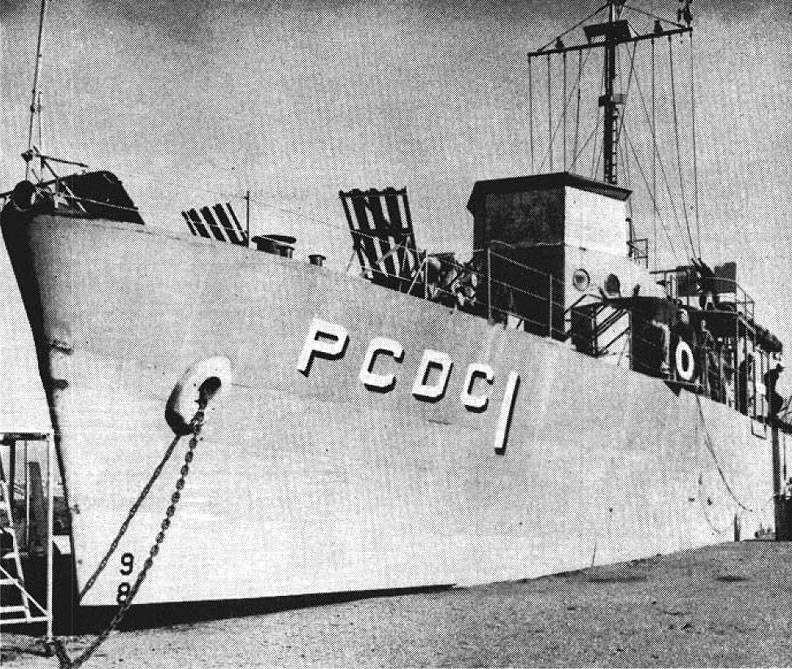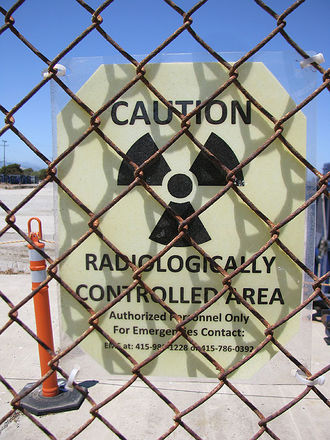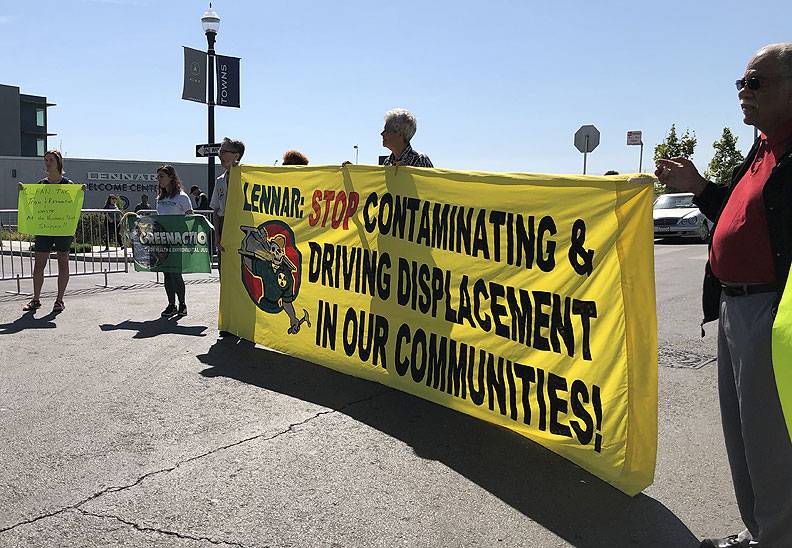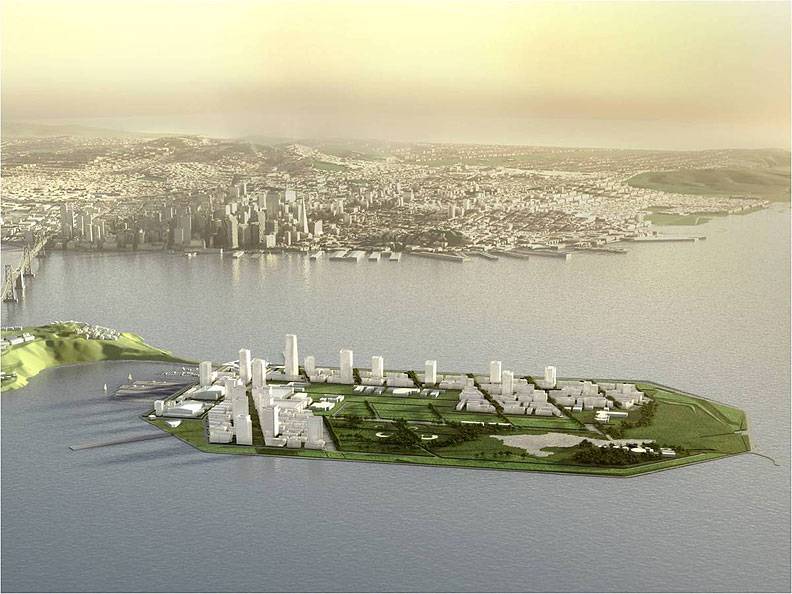Treasure Island’s Nuclear History: Difference between revisions
(Created page with "'''<font face = Papyrus> <font color = maroon> <font size = 4>Historical Essay</font></font> </font>''' ''by Eric Matsumoto, 2019'' {| style="color: black; background-color:...") |
(No difference)
|
Revision as of 20:59, 12 August 2019
Historical Essay
by Eric Matsumoto, 2019
| Treasure Island, sitting off the coast of San Francisco, is intimately linked with a history of nuclear activity. Starting in Word War II through the Cold War, the Navy operated a base on the island. There, the Navy hosted nuclear war academies to prepare sailors for nuclear and chemical warfare and also used the base to clean contaminated ships and dispose of waste. In the 1990’s the naval base was closed and transferred to civilian control and today, many civilians, especially the poor and formerly homeless, live on the island. However, Treasure Island’s nuclear legacy resurfaced when radioactive materials were discovered, raising health and environmental concerns. Treasure Island has become embroiled in an ongoing controversy surrounding redevelopment, affordable housing, environmental racism, and an ongoing scandal about mishandled cleanup practices at contaminated sites and the subsequent denial and cover-up by authorities. |
Aerial view of Treasure Island that sits off the Bay Bridge between San Francisco and Oakland.
Photo: C. Huang, courtesy sf.curbed
Treasure Island sits just off the coast of San Francisco along the Bay Bridge, connecting San Francisco and Oakland. The 400-acre artificial island was originally built to host the 1939-40 Golden Gate International Exposition. The Exposition was designed to highlight San Francisco and California as the gateway to the Pacific and celebrate the city as a cultural, political, and social hub.
The island was then considered as a potential site for a new airport, but the idea was soon abandoned due to other, more pressing concerns. In 1941, with the onset of World War II, the Navy took control of the island through the use of eminent domain and established a naval base and facility. During the war, the island processed approximately 12,000 military personnel per day for service overseas (Former naval station treasure island).
US Navy sailors in protective suits learn radiation techniques aboard the USS Pandemonium when it was used as a training ship.
Photo: The Masthead, Oct. 18, 1968, National Archives and Records Administration, San Bruno, CA
During its time under Navy control until the 1990’s, Treasure Island served as an important strategic location, but perhaps more importantly it became intertwined with the history of nuclear research and development. This history links Treasure Island with several other islands in the Pacific, located 4600 miles away (Smith & Mieszkowski, 2014). Starting in 1946, the United States tested 67 nuclear weapons on the atolls of the Marshall Islands. This “Pacific Proving Ground” became a laboratory where the military tested nuclear technological developments (Dillon, 2018). In “Operation Crossroads,” two atomic bombs were exploded over Bikini Atoll. Contaminated ships stationed at Bikini Atoll that had been drenched in radioactive fallout steamed across the Pacific into naval bases on the West Coast, where half a dozen ended up at Treasure Island according to Naval archives (Smith & Mieszkowski, 2014). There the ships were decontaminated, dismantled, repaired and in some cases used for educational purposes. One such ship, the USS Independence, was so dangerously radioactive that it was sunk off the coast of San Francisco near the Farallon Islands in 1951 (Smith & Mieszkowski, 2014).
As the United States prepared for the possibility of nuclear warfare, Treasure Island became the site of several nuclear war academies and training schools, often dealing with radioactive materials including radium, plutonium, and cesium 137 (Smith & Mieszkowski, 2014). The island’s damage control school sought to teach sailors methods for radiological protection and prepare them for atomic, chemical, and biological warfare (Dillon, 2018). The USS Pandemonium acted as a training vessel where radioactive materials were used to simulate nuclear fallout and sailors would wander the decks in rubber protective suits and learn to use Geiger counters (Dillon, 2018). Sailors also went on “treasure hunts” where they searched for buried radioactive objects that were planted as part of a training exercise (Harvey, 2019). Until the 1960s, the Navy also used to dispose of their radioactive materials and equipment in solid waste disposal areas, a technical term for large garbage pits on the island (Johnston, 2017).
The US Navy stationary training ship USS Pandemonium at US Naval Station Treasure Island. Radioactive materials were placed on the ship and used to simulate nuclear fallout and train sailors in radioactive detection and cleanup. The ship was built in 1957, used until 1969, and finally demolished in 1996.
Photo: Wikimedia Commons
In 1993, the Department of Defense selected the Treasure Island base for closure (Dillon, 2018). On September 30, 1997, the Naval Station at Treasure Island officially closed as part of the Base Realignment and Closure (BRAC) process, which sought to increase efficiency by closing military installations as the Cold War ended (Former naval station treasure island). The island was then turned over to the City of San Francisco and then to the Treasure Island Development Authority (Former naval station treasure island).
The Navy and their contractors set about dismantling and cleaning up the old base and preparing it to transfer to civilian control. This cleanup included dealing with the nuclear history of the island and the radioactive wastes left behind. In 2007, after many civilian residents were already living on Treasure Island, Robert McLean, a specialist working for New World Environmental, was assigned to conduct a survey of radiation. Despite the Navy’s assurances that the island was safe, McLean discovered a surprising amount of radioactive materials. He recounts, “We picked up readings from inside the truck, without even getting out of the vehicle” (Smith & Mieszkowski, 2014). He reported “finding radium pieces that emitted enough radium for a person at close range to receive, in an hour, five times the maximum radiation a nuclear worker is allowed to absorb in a year” (Smith & Mieszkowski, 2014). While the readings were not high enough to be sure to cause harm, they were certainly alarming. McLean tried to report his findings but was fired for not having adequately protected himself from the radiation. Company President Don Wadsworth stated that the Navy required the company to fire McLean or risk losing its contract (Smith & Mieszkowski, 2014). Instead of addressing the issue, the discovery set off a conflict between agencies and organizations with different stakes on Treasure Island.
Typical warning sign on fence separating residential area from radiation-contaminated areas on Treasure Island (this photo was taken in 2012).
Photo: Chris Carlsson
The Navy and their contractors continued to deny that Treasure Island was unsafe or that the cleanup had been mishandled while state health officials began to push for more investigations. Some city officials also downplayed the significance of any findings, possibly worried that concerns might risk slowing down future development as it had in other potentially contaminated areas around California (Smith & Mieszkowski, 2014). According to records, the Navy was warned of potential contamination and chastised for their waste disposal processes but did little to address these concerns. The Navy and the state’s toxics agency have continued to reassure residents that there is minimal risk and that the cleanup was going smoothly, despite further discoveries of radioactive waste and contamination, including the discovery of radioactive cesium 137 in 2013 (Smith & Mieszkowski, 2014). Residents have thus been unaware of the extent of the potential health risks.
Another site, just across the Bay Bridge sitting along the waterfront of San Francisco, closely mirrors Treasure Island’s story. That site is Hunter’s Point Shipyard. Carol Harvey, who writes for the SF Bayview and one of the few reporters who covers Treasure Island, refers to them as “Siamese twins” (Harvey, 2019). Following “Operation Crossroads,” where naval ships were subjected to radioactive fallout, these ships not only found their way to Treasure Island but also to Hunter’s Point where they were cleaned, contaminating many sites. The shipyard was also home to a nuclear defense laboratory that conducted radioactive experiments (Myers, Wagner, Witte, & Villarreal, 2018). Similar to Treasure Island, Hunter’s Point is also in the process of a radioactive cleanup and the site of planned redevelopment. However, one of the Navy’s lead contractors for decontamination efforts was caught falsifying records and tests. As a result, two former Tetra Tech supervisors were later sentenced to prison and Tetra Tech was subsequently sued by the government (Myers, Wagner, Witte, & Villarreal, 2018). The story picked up news coverage and became a major scandal, thanks to the efforts of grassroots activists and whistleblowers within the company that came forward to report mishandling of the cleanup (Harvey, 2019).
While Treasure Island and Hunters Point seem like twin entities, Hunters Point has received much greater coverage than Treasure Island. And yet the two sites were exposed to a lot of the same radiation and are being cleaned by many of the same companies and agencies. In an interview, Harvey claims, “They find one radiological object on Hunter’s Point and the news blows up, but they find 1280 objects on Treasure Island and there’s complete silence. The media doesn’t write about it at all.” (Harvey, 2019) In fact, according to Harvey, there has also been a media blackout on the subject. The Chronicle and the Examiner have largely ignored Treasure Island and most officials downplay any health risks posed by the situation. Harvey argues that many powerful players have a financial stake in the redevelopment of Treasure Island (Harvey, 2019). According to Harvey, “Dianne Feinstein, the senator from California, Nancy Pelosi, who is the representative of California, Willie Brown, the former mayor [of San Francisco] and the Navy all stand to gain financially – personally, financially – from the redevelopment of Treasure Island.” (Harvey, 2019) Such politicians advocated strongly for redevelopment and some have family or business ties to the corporations overseeing development, including the developer Lennar Corporation. Some activists have also accused them of preventing investigations into falsification of reports of the cleanup by Tetra Tech (United Public Workers for Action, 2018). The redevelopment companies, agencies, and housing authorities themselves also have incentives to cover up or downplay anything that would prevent the cleanup and subsequent redevelopment from moving forward. Harvey describes the situation as a “huge scandal that is being covered up” (Harvey, 2019). According to Harvey, Treasure Island, along with Hunters Point, is technically designated a Superfund site, meaning it has been classified as a polluted location requiring long-term cleanup of hazardous materials. Superfund sites are the most dangerous, polluted sites in the country. However, “if you if you look up the National Priorities List of Superfund Sites, you try to find a Superfund number or the mention of Treasure Island on the National Priorities List of Superfund Sites — which is online — you will not find Treasure Island there” (Harvey, 2019). Such practices make it hard for residents to be informed about the situation and potential risks of where they are living.
Protesters at Hunters Point protest the Lennar Corporation who is involved in the redevelopment there and on Treasure Island. Activists at Hunters Point were crucial in exposing the contamination and mishandled cleanup of Hunters Point.
Photo: courtesy GreenAction
At the time of the last census in 2010, it was reported that over 2000 civilian residents lived on Treasure Island (Johnston, 2017). Given the severity of San Francisco’s housing shortage, it is an attractive location for its low rents. Harvey says that the island is “one of the last holdouts for anything approaching affordable housing” in San Francisco. The City also viewed it as a potential way to address homelessness. Starting in 1997, the City effectively moved the homeless – mainly poor people of color – from the city streets to toxic Treasure Island. (Harvey, 2017) Many formerly homeless residents received subsidies from HUD and other organizations that sponsored the housing programs, and were able to live on the island. Many of these programs are found under the Treasure Island Homeless Development Initiative (TIHDI), an umbrella organization that provides services to the homeless. Due to these programs, the island is disproportionately composed of poor and marginalized groups. Three-fourths of the residents are people of color. Harvey calls this “one of the most egregious cases of environmental racism in the United States.” The poor and marginalized groups face the environmental and health consequences posed by the radioactive contamination and have few options for recourse (Harvey, 2019). Since the initial report by McLean in 2007, radioactive objects have been found in playgrounds, in neighborhoods, and in backyards (Smith & Mieszkowski, 2014). The fence that separates civilian residences from the solid waste disposal areas is within feet of ongoing cleanup activities. Some residents, many of whom Harvey has met in her visits to the island, have also shown signs of illness, likely linked to the contamination. Given the status of many formerly homeless residents, who must report to social workers and rely on homeless programs for their welfare, few residents speak out for fear of eviction or losing support. (Harvey, 2019) Coupled with efforts to cover up or downplay any potential hazards, Treasure Island residents are often left with no voice.
In 2011, the City approved a new development for the project that would transform Treasure Island and create “8,000 new homes, 500 hotel rooms, 300 acres of parks, 140,000 square feet of retail and 100,000 square feet of office space” (Robinson, 2017). The new project is supposed to take advantage of sustainable and green designs, for example by incorporating a solar farm and positioning buildings to soak up warmth efficiently (Torres, 2016). The new project is also set to be a mixed-income neighborhood and with many more public amenities. While the project has its supporters, it also has its detractors. With the new redevelopment, the tenants of Treasure Island – largely poor and people of color – are at risk of eviction and will likely be forced out. Having already suffered the health consequences, these residents will be displaced once again (Harvey, 2019). A resident of Treasure Island, Ben Reyes, worries about what will happen when “the city demolishes his apartment to make way for new development” in which case “he’s likely to get kicked out, with very little help” (Johnston, 2017). The estimated project completion is in 2032 (Torres, 2016).
A model of what the planned redevelopment of Treasure Island will look like, including new homes, buildings, and public amenities featuring sustainable urban planning.
Image: Skidmore, Owings & Merrill
Works Cited
Dillon, L. (2018). The navy’s legacy on treasure island Former naval station treasure island Harvey, C. (2017, Sept 1,). Death camp treasure island. San Francisco Bayview
Harvey, C. (2019). In Matsumoto E. (Ed.), Treasure island interview
Island history Johnston, A. (2017). [ https://www.kalw.org/post/hey-area-should-we-still-be-worried-about-radioactive-waste-treasure-island Hey area: Should we still be worried about radioactive waste on treasure island?]
Myers, S., Wagner, L., Witte, R. & Villarreal, M. (2018). Hunters point contamination, cleanup and development.
Robinson, M. (2017). [ https://www.businessinsider.com/photos-of-treasure-island-san-francisco-transformation-2017-8 This former radioactive-waste site off the coast of San Francisco is turning into a $5 billion housing development].
Smith, M., & Mieszkowski, K. (2014). Treasure island cleanup exposes navy’s mishandling of its nuclear past.
Torres, B. (2016, Jun 24,). [ https://www.bizjournals.com/sanfrancisco/news/2016/06/24/5-billion-san-francisco-treasure-island-structures.html Treasure island is set to become San Francisco's new $5 billion neighborhood]. San Francisco Business Times
United Public Workers For Action. (2018). On Father's Day: Pelosi & Feinstein partners in crime at Hunters Point & Treasure Island.

